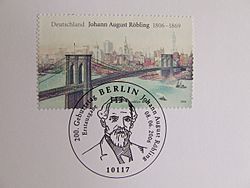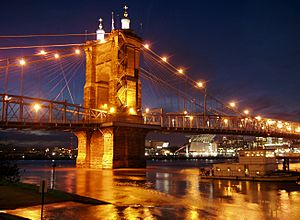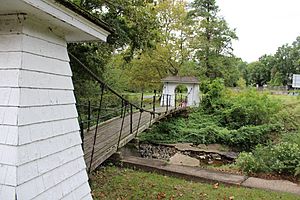John A. Roebling facts for kids
Quick facts for kids
John A. Roebling
|
|
|---|---|
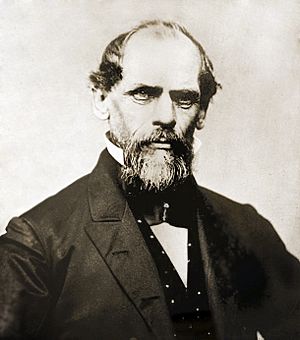
circa 1866
|
|
| Born |
Johann August Röbling
June 12, 1806 Mühlhausen, Kingdom of Prussia
|
| Died | July 22, 1869 (aged 63) New York City, U.S.
|
| Nationality | Prussian → American |
| Known for | Brooklyn Bridge John A. Roebling Suspension Bridge |
John Augustus Roebling (born Johann August Röbling; June 12, 1806 – July 22, 1869) was a talented civil engineer who was born in Germany and later became an American citizen. He was famous for designing and building wire rope suspension bridges. His most well-known work is the Brooklyn Bridge, which is now a very important historical landmark in engineering.
Early Life and Learning
John Röbling was born to Friederike Dorothea Röbling and Christoph Polykarpus Röbling. His mother noticed he was very smart when he was young. She arranged for him to have special lessons in math and science in Erfurt when he was 15.
In 1824, he passed his surveyor's test. Later that year, he went to the Bauakademie in Berlin for two semesters. There, he studied architecture and engineering. He also learned about building bridges, foundations, and how water systems (hydraulics) work. John also took classes from a famous thinker named Georg Wilhelm Friedrich Hegel. He became very interested in how the world works and even wrote a long book about his own ideas on the universe years later.
In 1825, Roebling got a government job in the Arnsberg province. He moved to Eslohe and spent four years designing and overseeing the building of military roads. During this time, he drew plans for suspension bridges over the Ruhr and Lenne rivers, but these bridges were never built. He returned home in 1829 to prepare for another engineering exam, but he never took it.
Building a Career
On May 22, 1831, John Roebling left Prussia with a group of people moving to the United States. They included his brother Carl. Engineers in Prussia found it hard to get ahead because of the Napoleonic Wars and political problems.
John and Carl Roebling bought land in Butler County, Pennsylvania in 1831. They wanted to start a German settlement called Saxonburg. John Roebling's house in Saxonburg is now a historic place.
When they arrived, the U.S. economy was doing well, but then a financial crisis hit in 1837. This made it harder for everyone, especially farmers. By the 1840s, things got better. People in America wanted to expand the country and improve transportation between cities and farming areas.
Even though many railway projects were happening near his home, Roebling first tried farming. After five years, he married Johanna Herting. But farming wasn't what he wanted to do, and Saxonburg didn't attract many new settlers.
In 1837, after his first child was born and his brother Carl died, Roebling went back to engineering. He first worked on projects to make rivers easier to travel on and to build canals. For three years, he surveyed land for railway lines across the Allegheny Mountains in Pennsylvania.
In 1840, Roebling wrote to suspension bridge designer Charles Ellet, Jr.. He offered to help design a bridge near Philadelphia, saying he had studied suspension bridges a lot in Europe. He believed that one good suspension bridge in Philadelphia would show Americans how useful and beautiful they could be.
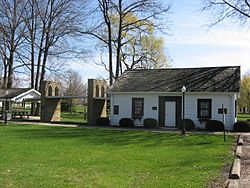
At that time, canal boats were moved over the Allegheny Mountains on railroad cars using thick hemp ropes. These ropes were expensive and wore out quickly. Roebling remembered reading about wire rope. Soon, he started making his own 7-strand wire rope on his farm. In 1841, he began producing wire rope in Saxonburg for suspension bridges and other projects like the portage railroad.
In 1844, Roebling won a project to replace a wooden canal aqueduct over the Allegheny River. His design used seven spans, each with a wooden trough to hold water. This trough was supported by strong cables made of many wires wrapped together. In 1845, he built a suspension bridge over the Monongahela River in Pittsburgh.
In 1848, Roebling started building four suspension aqueducts for the Delaware and Hudson Canal. During this time, he moved to Trenton, New Jersey. In Trenton, he built a large factory to make wire for his growing company, John A. Roebling's Sons Company. This factory led to Trenton's famous motto: "Trenton Makes, the World Takes."
Roebling's next big project, starting in 1851, was a railroad bridge connecting New York and Canada over the Niagara River. It took four years to build. The bridge was 825 feet (251 m) long and supported by four thick wire cables. It had two levels, one for vehicles and one for trains.
While the Niagara bridge was being built, Roebling designed a railway suspension bridge over the Kentucky River. This bridge needed a very long span of 1,224 feet (373 m). The foundations and stone towers were finished, but the railway company ran out of money, so the bridge was never completed by him. What is now called the High Bridge was later finished as the first cantilever bridge in the U.S. It is still used by trains today.
In 1859, Roebling finished another suspension bridge in Pittsburgh over the Allegheny River. His son Washington Roebling worked with him on this project after finishing his engineering degree.
The American Civil War paused Roebling's work. In 1863, building restarted on a bridge over the Ohio River in Cincinnati, which Roebling had begun in 1856. He finished this bridge in 1867. The Cincinnati-Covington Bridge was later named the John A. Roebling Suspension Bridge in his honor. When it was finished, it was the longest suspension bridge in the world.
His Final Project and Death
In 1867, Roebling began designing the famous Brooklyn Bridge, which crosses the East River in New York City. On June 28, 1869, while working near the bridge site, his foot was crushed by an arriving ferry. His injured toes had to be removed. He refused more medical help, wanting to treat his foot with "water therapy." His health got worse, and he sadly died on July 22, 1869, from tetanus at his son's home in Brooklyn. This was 24 days after the accident.
His son Washington Roebling became the chief engineer for the Brooklyn Bridge project. However, Washington also became very ill while working on the bridge's underwater foundations. His wife, Emily Warren Roebling, then bravely took over and helped complete the bridge in 1883. John Roebling is buried in the Riverview Cemetery in Trenton, New Jersey.
His Lasting Impact
John Roebling developed a special way to figure out how strong his bridges needed to be. He would calculate the weight of the bridge and the traffic on it, then add a lot of extra safety to make sure it was super strong. This method helped him build very safe and long-lasting structures.
Roebling's company, John A. Roebling's Sons Co., later provided the cables for the famous Golden Gate Bridge in San Francisco, California, which was built from 1933 to 1937. So, even after his death, Roebling's legacy helped build another amazing engineering wonder.
Key Projects
- 1844 Allegheny Aqueduct Bridge – in Pittsburgh; later taken down in 1861.
- 1846 Smithfield Street Bridge – in Pittsburgh; replaced later.
- 1848 Lackawaxen Aqueduct – crossing the Lackawaxen River in Lackawaxen, Pennsylvania; no longer standing.
- 1849 Roebling's Delaware Aqueduct – crossing the Delaware River from Lackawaxen, Pennsylvania to Minisink Ford, New York; now used for cars and people, restored in 1965 and 1995.
- 1850 High Falls Aqueduct – one span of 145 feet (44 m).
- 1850 Neversink Aqueduct – crossing the Neversink River; one span of 170 feet (52m).
- 1854 Niagara Falls Suspension Bridge – crossing the Niagara River from Niagara Falls, New York to Niagara Falls, Canada, 821 feet (250 m) long.
- 1859 Allegheny Bridge – in Pittsburgh; 344-foot (105 m) spans.
- 1866 John A. Roebling Suspension Bridge – crossing the Ohio River from Cincinnati, Ohio to Covington, Kentucky; 1,057 feet (322 m) long.
- 1883 Brooklyn Bridge – crossing the East River from Manhattan to Brooklyn in New York City; 1,595 feet (486 m) long.
- 1898 Ojuela Bridge (Puente de Ojuela) – a suspension bridge at a goldmine site in Durango, Mexico; 271.5 meters long.
Honors
- In 2006, the German postal service, Deutsche Post, honored Roebling's 200th birthday with a special stamp.
- His hometown of Mühlhausen named the "John-August-Roebling-Schule" (John-August-Roebling School) after him.
Family Life
John Roebling was the youngest of four children. He was baptized in the Lutheran church Divi Blasii in Mühlhausen. As a boy, he played the bass clarinet and the french horn. He was also very good at drawing and painting. His father had a small tobacco shop, but it wasn't enough to support all three sons. John and his brother Carl moved to the United States and first settled in Pennsylvania.
John Roebling and Johanna Herting had nine children:
- Son: Washington Augustus Roebling (born 1837, died 1926)
- Daughter: Laura R. Methfessel (born 1840, died 1873)
- Son: Ferdinand William Roebling (born 1842, died 1917)
- Daughter: Elvira R. Stewart (born 1844, died 1871)
- Daughter: Josephine R. Jarvis (born 1847)
- Son: Charles Gustavus Roebling (born 1849, died 1918)
- Son: Edmund Roebling (born 1854, died 1930)
- Son: William Elderhorst Roebling (born 1856, died 1860)
- Daughter: Hannah Roebling (died as a baby)
Roebling's son Washington Roebling and his daughter-in-law Emily Warren Roebling continued his work on the Brooklyn Bridge. His son Ferdinand helped expand the wire rope business. His son Charles Roebling designed a huge machine to make wire rope and founded the town of Roebling, New Jersey. This is where the John A. Roebling's Sons company steel mill was built.
His grandson Washington A. Roebling II died as a passenger on the RMS Titanic. His great-grandson Donald Roebling was a well-known inventor who created the amphtrack, a special vehicle that could travel on both land and water. His great-great-grandson Paul Roebling was a respected actor.
See also
 In Spanish: John Augustus Roebling para niños
In Spanish: John Augustus Roebling para niños


